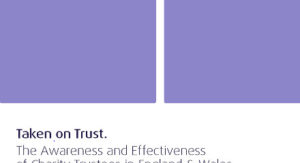The findings of the Charity Commission's new report into trusteeship offer challenges for the sector. David Ainsworth asks what needs to happen next.
Trusteeship is a country for old men. Particularly, if today’s report is to be believed, old white men from a professional background who are drawing a good pension.
Taken on Trust, the Charity Commission’s report into trusteeship, paints a mixed picture, inevitably, but it presents some very clear challenges. Trustee boards lack certain skills. They are isolated from the wider sector, and not accessing the support on offer. And there is an issue around diversity, compounded by what the report’s author, Stephen Lee of Cass Business School, calls “the profound informality of the recruitment process”.
This report sets the charity sector two very clear problems, and the start of some solutions to them: we must improve diversity by improving recruitment; and we must improve skills and knowledge by improving access to support.
For me, though, the key question is what needs to happen next, and who needs to do it.
It is not absolutely clear that the various sector bodies know how to proceed. It seems possible, in particular, that the Commission and the charity infrastructure sector will look at each other for a while, both keen that the other do something, and nothing will really change.
Two sectors (or more) not one
The first thing to consider is segmentation. This report highlights clearly that it’s probably really unhelpful to talk about the charity sector. There are really two sectors – perhaps more – which blend into one another at the margins.
Any solution must recognise a clear liminal zone – the grey area which lies between charities which do not have paid staff, and those which do. Here, we are really discussing two or more distinct groups of organisations which lie on either side of that zone, which have incredibly different needs. Those needs must be addressed separately.
The report finds that 80 per cent of charities have no employees or volunteers, so trustees are the only people involved. So most charity trustees are not actually involved in governance, in the conventional sense. There is literally no one for most of them to govern.
A glance at the register reveals that the small charities which fit this model are overwhelmingly community-based. They are the cast of the Village Green Preservation Society: PTAs, scout groups, village halls, WIs, amateur theatres, church halls, community associations, playgroups, rotary clubs, and choirs. And many other similar bodies.
The report shows that there are around 134,000 of these organisations, but even this downplays it. NCVO estimates suggest that there may be as many charities again which fall into this category but do not sit on the register, either because they are too small or they fall into an excepted category.
Then there is a liminal zone, comprising those charities with annual incomes between £100,000 and £500,000.
And on the other side, above £500,000, lies a professional sector, comprising maybe 25,000 charities where the staff do the work, and the trustees oversee it.
When thinking of governance and regulatory models, it would probably also be helpful to distinguish the majority of these professional organisations from the 100 or so very largest, and to segment by cause, and by main income source – fundraising, trading, investment and so on. But those points are probably for another day. The key division in this report is between voluntary and professional.
Diversity
At first glance, it looks self-evidently true that diversity is a huge problem for charity boards. The report finds that 92 per cent of trustees are white; 64 per cent are male; 51 per cent are retired; 75 per cent earn more than the median income; and 60 per cent hold some sort of professional qualification. The average age of a trustee is 61, four years older than we previously thought.
Only 5 per cent of the charity sector’s trustees were recruited through a job advert. In contrast, 70 per cent were approached by an existing trustee. Around 71 per cent were recruited informally, 23 per cent formally. The rest is unclear.
The small voluntary bodies tend to have boards which are older but less male. It is not necessarily the case that the age group of their boards is that unrepresentative, because many of their organisations are overwhelmingly used by older people – who are also much whiter than the general population. In many cases the youngest people who will engage with them are parents of young children. And rightly or wrongly, these charities are also more common in affluent areas.
It is hard to level any criticism at these bodies. Their trustees are the people willing to do the job. They are giving up substantial time for relatively little reward, in order to provide a service for their peers. Given the difficulties of social disengagement faced by many elderly white men, perhaps – rather than complaining – we should be celebrating that they are finding something meaningful and making a strong contribution.
But I’m not sure we can make the same excuses of the professional charities – those where the staff do the delivery, and the board do the governance. These organisations do need to be aware that, as the Commission itself has said clearly, “diverse boards make better decisions”. They need to make improvements.
I think these charities end up with boards of old white men partly because they tend to want to recruit highly skilled people with a particular status – senior lawyers, accountants, businessmen – and those people are disproportionately old white men.
Of all these issues, age is the least important. Trusteeship is time-consuming and, if we’re honest, a little dull at times. It’s not surprising that older people are the key demographic. But there are massive issues with ethnicity, gender and, most of all, class. Because while it’s easy to measure age, gender and so on, the real benefit of diversity to charities comes from getting different viewpoints around the table. Surely no one believes for a second that we’ll have made much progress if we chuck a bunch of old white men off charity boards, and replace them with their wives.
The report recommends a number of measures to improve diversity which target those who could be recruited. It wants to set up a national recruitment database, and campaign to make trusteeship more appealing to others.
It may be that formalising recruitment might make things even worse. If it starts to look more and more like a job interview, more and more board spots might go to those with the best formal qualifications. If that happens, trustee boards will look increasingly like the House of Lords.
I worry about the database, too. There are a lot of trustee recruitment databases already – too many, arguably – and none has ever gathered any traction. If one could be made to work, it would indeed be a fantastic resource, but creating a new one seems to be of questionable value. Instead of 30 competing schemes – or however many there are – there would now be 31.
It’s also pretty clear that the problem lies in trustee boards. They are the ones who are recruiting informally, largely in their own image. They need to be persuaded otherwise. Unless we make progress on that front, databases and campaigns will achieve little.
So they have to be told. We need to make this point everywhere we can: recruit formally, and recruit diversely. Recruit in threes, because research shows that brings greater diversity.
Maybe we could use something like the Rooney Rule, which says that every team in the NFL must at least interview a black person for every coaching job.
Mostly, the Charity Commission has to do it. We’ve discovered in this report that trustees listen to precisely two sources of information: one another, and the Charity Commission. Basically it stands to reason that if anyone apart from the regulator suggests change, they will probably be ignored.
Improving support
The same thing holds true of support: the Commission must do it.
The report identifies that these boards are not accessing a wide range of support, and suggests we find ways of broadening that support. It also identifies clearly that what trustees want is not information and knowledge, but skills. They are getting a lot of information about their duties and the law, but they don’t know how to do a good job.
Again, we need to think in terms of voluntary and professional.
The voluntary question is the harder one. It’s questionable how much support we can usefully provide to village halls and PTAs. There are a lot of them, and they’re very isolated. We have to accept that at this level, skills are low, and likely to remain low.
Among professional charities, there are more levers to pull. We can lobby the staff to lobby the board, if nothing else.
Ultimately, though, it seems pretty clear that if we want a solution, it will have to come through the Commission. The research shows pretty clearly that is the only body – other than each other – that trustees pay any attention to. It seems odd to say that we should try and get them to venture out into what is categorised as a messy, diffuse, and hard to follow landscape of providers, rather than just giving them what they need in the one place where they are effectively a captive audience.
The Commission is clearly cognisant of this. It is signalling that – having moved to a regulation-first approach – it is now considering a move back.
It’s hard to argue that the regulation-first approach was wrong. It’s clear that for a long time the regulator was not effectively addressing wrongdoing, and that has not been fully addressed, even now. It is the only organisation which can do this, whereas lots of people can provide advice and support.
The only flaw appears to have been that charities don’t want advice from lots of people, they want it from the Commission. So the Commission needs to be resourced to provide advice, one way or another.
How to make it happen
The Commission is actually a bit hamstrung in what to say. It can’t tell trustees how to do it, and it’s quite limited in the suggestions it can make.
So we need a bit of a hybrid response – hosted by the Commission, but delivered by people who are actually allowed to make solid recommendations, rather than saying “In the end, it’s all up to the trustees”.
The final question is how to pay for it. It’s obviously really good value for money, but it involves a small amount of value accruing to each of a very large number of very small organisations. The Commission’s answer is that the sector should pay for this through a deeply unpopular levy which will generate anything up to another year or two of internecine wrangling. The sector’s answer is that the government should pay, but there is a major problem here. What if the government won’t?
While it seems unusual for a journalist to argue against a long, protracted wrangle that will no doubt generate yards of copy, we all have to make sacrifices for the common good. I think we here at Civil Society would be happy to forego the upcoming bunfight over Commission funding if only someone, somewhere, in the sector were to realise the value of good governance, and simply step up to pay for it themselves.
|










